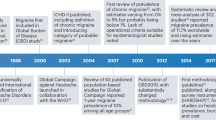Abstract
Several international campaigns to increase awareness on the high burden of migraine stimulated population-based studies in the last few years that provided broader data on prevalence, correlates, and impact of migraine. The last version of the Global Burden of Disease 2010 posed migraine with a twofold increase with respect to the previous version as one of the first disabling diseases. Migraine, and in general headache disorders are among the top ten causes of disability because they are common and disabling: that is now clear. It is also clear that the descriptive epidemiology of migraine has reached its maturity. The prevalence rates and sociodemographic correlates have been stable across 50 years. Last but not least, despite international efforts an illness that can be relieved does not, and the heavy burden that it poses at individual and societal levels, persists when it could be mitigated. Describing and accounting the burden of migraine worldwide is not enough anymore, we need to change our paradigm again and move towards new pathways. The opportunity is provided by the biopsychosocial approach that enables to act on the environment once the most adequate medical therapy has been provided. To reduce the burden, international efforts should focus certainly on development of new drugs but mainly on improving health care systems’ response to millions of migraine and headache sufferers.
Similar content being viewed by others
References
Steiner TJ (2004) Lifting the burden: the global campaign against headache. Lancet Neurol 3:204–205
Stovner LJ, Andree C (2010) Prevalence of headache in Europe: a review for the Eurolight project. J Headache Pain 11:289–299
Vos T, Flaxman AD, Naghavi M et al (2012) Years lived with disability (YLD) for 1160 sequelae of 289 diseases and injuries 1990–2010: a systematic analysis for the Global Burden of Disease Study 2010. Lancet 380:2163–2196
Stovner LJ, Hagen K, Jensen R et al (2007) The global burden of headache: a documentation of headache prevalence and disability worldwide. Cephalalgia 27:193–210
World Health Organization and lifting the burden (2011) Atlas of Headache Disorders and Resources in the World 2011. WHO, Geneva
Linde M, Gustavsson A, Stovner LJ et al (2012) The cost of headache disorders in Europe: the Eurolight project. Eur J Neurol 19:703–711
Steiner TJ, Birbeck GL, Jensen R et al (2010) Lifting the burden: the first 7 years. J Headache Pain 11:451–455
Steiner TJ, Stovner LJ, Birbeck GL (2013) Migraine: the seventh disabler. J Headache Pain 14:1
Leonardi M (2014) Higher burden of migraine compared to other neurological conditions: results from a cross-sectional study. Neurol Sci 35:S149–S152
Murray CJL, Ezzati M, Flaxman AD et al (2012) GBD 2010: design, definitions, and metrics. Lancet 380:2063–2066
D’Amico D, Grazzi L, Usai S et al (2011) Disability in chronic daily headache: state of the art and future directions. Neurol Sci 32:S71–S76
Merikangas KR (2013) Contributions of epidemiology to our understanding of migraine. Headache 53:230–246
Leonardi M, Steiner TJ, Scher AT, Lipton RB (2005) The global burden of migraine: measuring disability in headache disorders with WHO’s classification of functioning, disability and health (ICF). J Headache Pain 6:429–440
World Health Organisation (2001) The International Classification of Functioning, Disability and Health-ICF. WHO, Geneva
Raggi A, Leonardi M, Ajovalasit D et al (2010) Disability and functional profiles of patients with migraine measured with ICF classification. Int J Rehabil Res 33:225–231
Leonardi M, Raggi A, Bussone G, D’Amico D (2010) Health-related quality of life, disability and severity of disease in patients with migraine attending to a specialty headache center. Headache 50:1576–1586
Raggi A, Leonardi M, Bussone G, D’Amico D (2013) A 3-month analysis of disability, quality of life and disease course in patients with migraine. Headache 53:297–309
Raggi A, Leonardi M, Giovannetti AM et al (2013) A 14-month study of change in disability and mood state in patients with chronic migraine associated to medication overuse. Neurol Sci 34:S139–S140
Raggi A, Schiavolin S, Leonardi M et al (2015) Chronic migraine with medication overuse: association between disability and quality of life measures, and impact of disease on patients’ lives. J Neurol Sci 348:60–66
Conflict of interest
I certify that there is no actual or potential conflict of interest in relation to this article.
Author information
Authors and Affiliations
Corresponding author
Rights and permissions
About this article
Cite this article
Leonardi, M. Burden of migraine: what should we say more?. Neurol Sci 36 (Suppl 1), 1–3 (2015). https://doi.org/10.1007/s10072-015-2188-z
Published:
Issue Date:
DOI: https://doi.org/10.1007/s10072-015-2188-z




